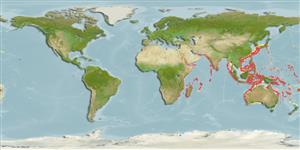Environment: milieu / climate zone / depth range / distribution range
Ökologie
seewasser bathydemersal; tiefenbereich 100 - 500 m (Ref. 11897). Deep-water
Indian Ocean: from the Andaman Sea and may extend nearby (i.e. India).
Size / Gewicht / Alter
Maturity: Lm ? range ? - ? cm
Max length : 10.0 cm TL Männchen/unbestimmt; (Ref. 6612)
Rückenflossenweichstrahlen (insgesamt) : 5; Afterflossenstacheln: 0; Afterflossenweichstrahlen: 4. This species is characterized by the following: subopercular buckler dull, with many small blunt spinelets at its tip; the ventral surface is covered with small- to mid-bucklers, totally naked between these bucklers; relatively short and blunt rostrum, directed upward; principal bucklers on dorsal surface relatively small and low; dorsal surface with few brown rings (Ref. 86633).
A benthic species (Ref. 75154) found on the continental slope (Ref. 7300, 75154).
Life cycle and mating behavior
Maturities | Fortpflanzung | Spawnings | Egg(s) | Fecundities | Larven
Paxton, J.R., D.F. Hoese, G.R. Allen and J.E. Hanley, 1989. Pisces. Petromyzontidae to Carangidae. Zoological Catalogue of Australia, Vol. 7. Australian Government Publishing Service, Canberra, 665 p. (Ref. 7300)
IUCN Rote Liste Status (Ref. 130435)
Bedrohung für Menschen
Harmless
Nutzung durch Menschen
Tools
Zusatzinformationen
Download XML
Internet Quellen
Estimates based on models
Preferred temperature (Ref.
123201): 11.8 - 22.9, mean 15.9 °C (based on 294 cells).
Phylogenetic diversity index (Ref.
82804): PD
50 = 0.5001 [Uniqueness, from 0.5 = low to 2.0 = high].
Bayesian length-weight: a=0.01000 (0.00244 - 0.04107), b=3.04 (2.81 - 3.27), in cm total length, based on all LWR estimates for this body shape (Ref.
93245).
Trophic level (Ref.
69278): 3.3 ±0.5 se; based on size and trophs of closest relatives
Widerstandsfähigkeit (Ref.
120179): mittel, Verdopplung der Population dauert 1,4 - 4,4 Jahre. (Preliminary K or Fecundity.).
Fishing Vulnerability (Ref.
59153): Low vulnerability (10 of 100).
